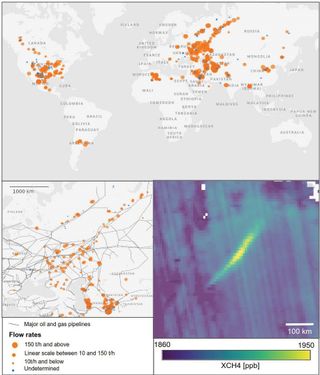Massive methane leaks mapped from space
Most of the released methane comes from oil and gas production.

Using satellite data, researchers have mapped massive plumes of methane released by human activities.
Those satellite images revealed that plumes of methane emitted by oil and gas facilities during leaks or maintenance operations made up about 8% to 12% of all oil and gas methane emissions, according to a new study.
"This work confirms what we have only glimpsed in previous studies of individual facilities and regions: that intermittent, large releases of methane from oil and gas operations are common globally and are mostly unreported," study co-author Riley Duren, a research scientist at the University of Arizona and CEO of Carbon Mapper, a nonprofit that works to monitor and reduce methane and carbon dioxide emissions, said in a statement.
"In this critical decade for climate action, this underscores the urgent need for persistent global observing systems that can detect, pinpoint and quantify methane emissions at scales relevant to decision making," Duren said.
Related: Landsat satellites: 12 amazing images of Earth from space
Methane is the second-most-common greenhouse gas emitted into Earth's atmosphere behind carbon dioxide, and more damaging for the climate than carbon dioxide in the short-term. A ton of methane released into the atmosphere traps about 80 times more heat than a ton of carbon dioxide over a 20 year period, according to the MIT Climate Portal.
To measure the methane released by human activities around the world between 2019 and 2020, researchers studied atmospheric methane images produced by the Tropospheric Monitoring Instrument aboard the European Space Agency's Sentinel-5P satellite, which measures methane in the atmosphere daily.
Sign up for the Live Science daily newsletter now
Get the world’s most fascinating discoveries delivered straight to your inbox.
The researchers found that about 1,200 (around two-thirds) of the visible "ultra-emitters" — sources producing more than 27.5 tons (25 metric tons) of methane per hour — came from oil and gas production, while the remaining one-third was split among coal, agriculture and waste management, according to the study.

Methane released during oil and gas production is likely a result of expected maintenance activities and unexpected malfunctioning equipment or leaks. Turkmenistan had the highest estimated methane emissions during the study period, followed by Russia, the U.S., Iran, Kazakhstan and Algeria. However, the researchers couldn't measure methane plumes in areas such as the U.S. Permian Basin or where oil is produced in Canada and China because the overall emissions in these regions were too high to make out individual ultra-emitters, The New York Times reported.
Preventing these methane plumes, either by enforcing leak detection or by reducing methane released during maintenance, would be the equivalent of removing 20 million vehicles from the road for a year, according to the study.
The findings were published Feb. 3 in the journal Science.
Originally published on Live Science.

Patrick Pester is a freelance writer and previously a staff writer at Live Science. His background is in wildlife conservation and he has worked with endangered species around the world. Patrick holds a master's degree in international journalism from Cardiff University in the U.K.
